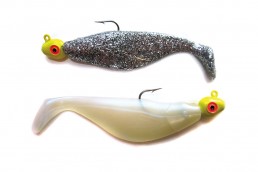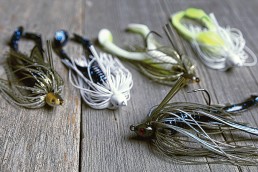Swim-jiggin’ 101
SHARE THIS POST
Swimming a jig has literally taken the country by storm, and is definitely one of the hottest tournament tactics on both regional and national trails. I can personally attest to the effectiveness of this tactic and the overall versatility of working a jig in this manner. The difference between working a jig in the more conventional manner—hopping or dragging it near or on the bottom—as opposed to swimming it is drastic in contrast. One has to literally retrain oneself in order to effectively fish this technique.
There are several key things to look for, particularly in a jig meant for this technique, that’s essential for optimum performance. For one, the best swim jigs have a line tie that’s positioned right at the nose of the jig, and not overhead or at an upward angle like many other similar-looking bass jigs. A line tie in this spot allows the jig to slither through grass far better too and also promotes a more horizontal action instead of a dropping motion. The better swim jigs on the market today, like those from Dirty Jigs, also have a slender, spearhead shape to them instead of a wider football design. This further enhances a swim jig’s ability to slither through the grass and brush effortlessly.
The actual weight of a typical swim jig tends to be on the lighter side. In fact, most bass jig manufacturers don’t even offer one over 1/4 ounce, but I’ve found many instances where the heavier weights are superior. Deep grass and windy conditions are the most obvious cover and conditions that merit a 3/8- to 1/2-ounce version. However, swim jigs as light as 1/8 ounce is highly effective for ultra-shallow water. Plus, they allow you to swim the jig just a few inches under the water, which can be highly effective in some situations.
Finally, the best swim jigs I’ve used have a high-tempered thin wire hook that sets quickly and easily. Combine this with a thinner brush guard or even a single cable guard and you’re able to set the hook better and miss fewer strikes. Conversely, heavy-gauge hooks and thicker fiber brush guards, though popular on many traditional bass jigs, are less desirable for swim jiggin’ because bass are able to easily expel the jig before a solid hook-set can be initiated. Heavy-duty jigs of this more traditional nature were meant for flippin’ and pitchin’ into thick cover. Strikes are more apt to occur during a pause, which allows the angler time to “load up” before setting the hook. Of course, heavy-duty hooks are necessary to pull bass out of thick jungles.
While traditional bass jigs require heavy-action rods and thicker, braided lines, swim jigs can be fished on both spinning and baitcast gear, medium-power rod actions and 10- to 20-pound-test mono, fluorocarbon or lighter-gauge braids. In fact, I rig my swim jigs on the same baitcast gear that I would normally fish a spinnerbait. Speaking of which, I essentially look at a swim jig as a spinnerbait without the spinner. With that in mind, I’ll generally fish a swim jig over, around and through cover that’s considered spinnerbait terrain. Will the spinnerbait outfish a swim jig? Yes. But there are instances when swim jigs outshines a spinnerbait.
Are you enjoying this post?
You can be among the first to get the latest info on where to go, what to use and how to use it!
The first instance involves spinner-shy bass, which often occurs on waters that receive fishing pressure. Any lake, river or reservoir that gets constant bass-tournament traffic is bound to have spinner-shy bass. Ultra-gin-clear lakes seem to have spinner-shy bass often too.
The second instance is where a swim jig outperforms a spinnerbait when overly thick grass is present. Grass renders any revolving spinnerblade ineffective since grass can wrap up in the swivel, destroying the spinner action. Swim jigs are far superior in this situation; they travel effortlessly through grass with minimal problems.
The third situation where swim jigs outperform spinnerbaits is in ultra-clear water. In some instances, the wire arm and blade hardware, as well as flash and vibration of the overall spinnerbait presentation, spooks clear-water bass noticeably. Yet, the same general presentation—no wire arm, no blades, and no vibration—draws a positive response. Swim jigs simply can’t be beat in this situation.
Experiment with various colors until you hit on a winner. Anglers prefer high-vis. patterns and colors more for the spinnerbaits such as white, chartreuse and similar hues. More often than not, I personally use louder patterns so I can keep tabs on the jig throughout a retrieve. When bass are aggressively chasing baitfish, these brighter patterns are superb. Yet, I have found darker swim jigs will outfish brighter patterns on some occasions. When bass are on a strong crawdad bite, the browns and dark greens are tough to beat. Any time bass seem to chase, but not commit to the baits, go darker and you’ll usually see their “attitude” improve.
Lastly, jig trailers are often key to success with swim jigs. I’m particular to Kalin’s soft plastics in this instance since they all have great tail action at ultra-slow speeds. Since you’re essentially casting the bait out and reeling it in, a jig trailer with built-in action really helps. Experiment with different actions, colors and combos until you hit on a winner. The next time you run into spinnerbait-shy bass, give the swim jig a try. It won’t be long before you become a big fan of this lure and technique.
MWO
SHARE THIS POST
Did you enjoy this post?
You can be among the first to get the latest info on where to go, what to use and how to use it!
Joe Bucher
Joe Bucher is a Freshwater Fishing Hall of Fame Legendary Angler, book author, lure designer and host of Fishing with Joe Bucher TV series.



